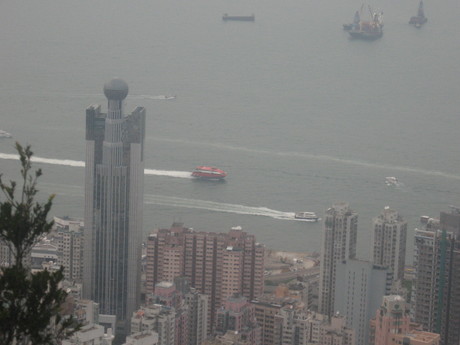On Tuesday the 11th I took a TurboJet ferry from Hong Kong to Macau. The ferry takes one hour to get to Macau. It is some quite fast design; some of the TurboJet ferries are hydrofoils, although I don't think the ones I took were. The ferry feels somewhat like an airplane, with assigned seating and very solid windows. This probably makes things more efficient, but also makes it hard to see much along the way. It is necessary to go through customs on both ends, but it seemed to be a streamlined process and I don't think they were checking anyone as much as at the airport.

Macau feels much like Hong Kong overall. However, the parts I saw were obviously well prepared for tourism, and were mostly well signposted and with good sidewalks. On the other hand, I gathered that this changed rapidly once out of the tourist areas. Signposts are usually in Chinese, Portuguese, and English. Unlike Hong Kong, scooters are common, although I think not as common as in Taiwan.
I only visited the Macau Peninsula. The rest of Macau consists of the islands of Taipa and Coloane, and Cotai, which is the reclaimed land between the two islands where the new casino and hotel projects are. All I saw of this was bridges going off to a shoreline which must have been the near edge of Taipa. One of these bridges started near the ferry terminal, and the ferries went under it when coming and going.


My Hong Kong guidebook had one tour of the area, so I mostly followed that. Here I use the mostly Portuguese names for things it gave, although I am not sure if that is the normal convention in English.
Walking towards the historic centre from the ferry terminal the first major sight was Fisherman's Wharf, a theme park on the waterfront with some open shopping areas. It has a number of themed areas mostly in pseudo-historical styles, including some classical Chinese buildings, a Roman amphitheatre, and a volcano. After passing Fisherman's Wharf there was an area (called Nape, I think) of what seemed to be large casinos and hotels.





Farther in on the peninsula was what is apparently the historic centre of Macau, Largo do Senado. This square is surrounded by a number of old buildings, which now mostly contain modern shops. On one end of the square is São Domingos, an old church which includes a museum of Catholic artifacts from the area. The streets near the square also have a few older buildings, and a lot more touristy shops, especially for food. The whole area was very crowded, and the mixing of the actual old buildings with modern tourist shops made things feel somewhat less genuine to me, and more like an extension of the casino area.







However, once off the tourist streets there were more streets that were less well maintained and had a fairly dense residential feel. Here shops were largely marked in only Chinese.


Near the Largo do Senado is the ruins of São Paulo, and the Fortaleza do Monte. São Paulo was a seventeenth century Jesuit cathedral which was mostly destroyed in a fire a couple hundred years ago. The remaining part is just the front façade, along with a few small bits of excavated ruins and a crypt containing remains of some of the Jesuit founders and Japanese Christian martyrs. The site also includes another small museum of Christian artifacts. The Fortaleza do Monte is a fortress of a similar age on a hill overlooking the ruins of São Paulo, which was originally also used by the Jesuits. The fort contains the Museum of Macau, which I didn't go in to. It also has good views out over the peninsula.





After seeing the Largo do Senado area and the ruins and fort, I went south west trying to follow what my guide book identified as the "well-signposted Historic Centre of Macau Trail". I didn't manage to find many sign posts, but went along what was probably the right street. The route was much quieter than the Largo do Senado area and lacked the tourist shops, but still seemed to be maintained for visitors and had a few more old buildings along the way (with sign posts to more). The street I was on ended at a small park between the A-Ma Temple and the Maritime Museum. The A-Ma Temple is a Mazu temple which predates the Portuguese arrival, and which is said to be the origin of the name Macau. By the park there was an accessible stretch of waterfront, which began after a harbour. As far as I can tell the other side of the water there is outside Macau.



I walked back to casino area and then the ferry terminal along a larger road between two lakes (or at least enclosed bodies of water) and the edge of the peninsula. This road connected to two more bridges to Taipa. I also went past Macau Tower, which has a mall and the world's tallest bungee jump.

